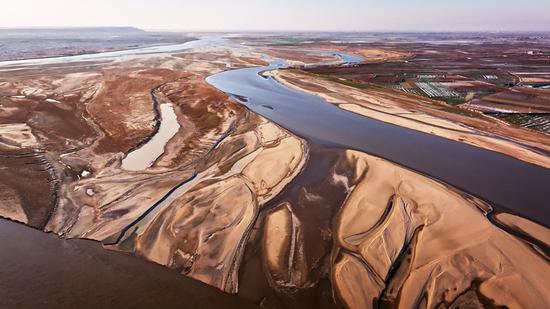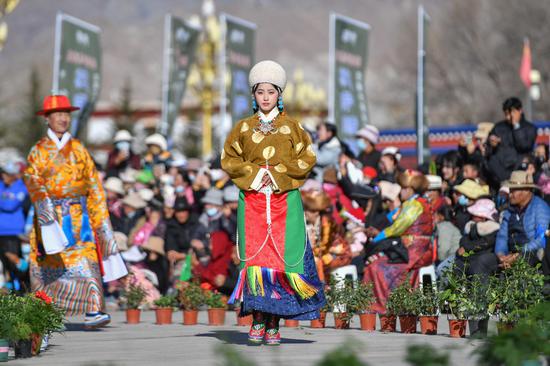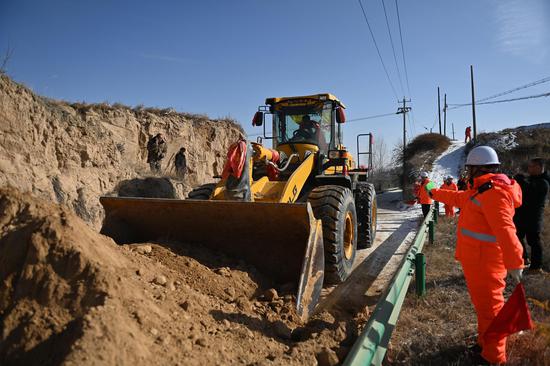
Four white-naped cranes feed on the shore of Poyang Lake in January last year. (Photo by Wang Jin/For China Daily)
Habitat loss
"This, in turn, enables us to conduct research on their food resources and assess their general survival situations," Jia said.
They discovered that the Bohai Bay area was a major staging site for the cranes, where they would roost and feed for "at least one week and sometimes, as long as one month" during their migration from their breeding grounds to the wintering grounds. "Now, however, it has changed to the Shandian River Basin in Duolun, Inner Mongolia autonomous region," Jia said.
To discover the reason for the change, they analyzed the crane's historical habitats in the Bohai Bay area and identified a significant issue — habitat loss.
They examined various habitats such as grasslands, marshes, open water and farmlands to determine if they had been converted into other forms or developed for human use, such as urban areas or highways. Based on historical records and their observations, they found a loss of suitable habitats for the cranes at their historical staging site.
As a result, the birds had changed their migration route. "Some cranes were unable to adapt and disappeared, while others, more resilient and intelligent, relocated to the Shandian River Basin," Jia said.
Jia and his teammates have counted over 800 white-naped cranes in the area each year, and the estimated population is now around 1,000. "That means almost all birds of the western population will spend some time in the Shandian River Basin during their migration," he said.
He said the negative impact of habitat change on the cranes was obvious in Beijing's Miyun Reservoir area.

Miyun case
The Miyun Reservoir was one of the capital's top birding sites until several years ago, and also a significant staging site for the white-naped crane. The northern shore of the Miyun Reservoir once had the highest bird diversity in Beijing, and had been a sanctuary for over 110 water bird species, Jia said.
In surveys conducted in 2013 and 2014, Jia and his team counted over 1,000 white-naped cranes at the site. "It could be considered a key stopover site for the cranes during their migration," Jia said.
However, Beijing is also a city with extremely limited water resources, and its underground water has been depleted due to a funnel-shaped geological structure. To address the water shortage, the massive South-to-North Water Diversion Project was carried out, and the Miyun Reservoir was designated as a backup water source for the project.
In 2015, the inflow of water from the Danjiangkou Reservoir in Hubei province caused the water level in the Miyun Reservoir to rise. The farmlands or shore areas that were previously suitable locations for cranes and other waterfowl to roost and feed became either wetlands or totally submerged.
While the rising water level in the reservoir might be good for some water bird species, such as ducks and cormorants, Jia said, it resulted in the decline of habitats for other species, such as cranes.
The decline in water bird diversity at the reservoir may not be irreversible, he said.
"Based on our satellite tracking data, we discovered that over 100 white-naped cranes temporarily stopped at the wetlands on the northern shore of the Miyun Reservoir from March 10 to 12," Jia said.
"It is a very rare record in recent years. It gives us hope. If we can restore the habitat of the Miyun Reservoir to a certain extent, water birds including the white-naped cranes are likely to continue using it as an important stopover site."

A single white-naped crane (second from right) joins a flock of common cranes flying over the Miyun Reservoir area in November 2013. (Photo by Chen Liang/China Daily)
Conservation strategy
He hopes better measures can be implemented in future large-scale projects to balance the relationship between conservation and development and achieve harmony between humans and nature.
Migratory water birds such as the white-naped crane need their habitats to be protected throughout their life cycle, he said, with any problems in breeding, resting, or wintering areas proving disastrous for migratory species.
The western population's breeding and wintering grounds are mainly within nature reserves and under better protection. However, Jia said, its staging and stopover sites — usually not in protected areas — need joint conservation efforts from scientists, local governments and people, conservation NGOs and volunteers.
In the Shandian River area, he said their research work had received local herders' support. "We helped them establish a volunteer association to protect birds in the area and provided training to volunteers," Jia said. "In this way, all relevant stakeholders can work together to protect the cranes."
He said the Chinese population of the white-naped crane had remained almost stable for a decade, and "with further research, we expect to find better ways to restore the population".


















































 京公網安備 11010202009201號
京公網安備 11010202009201號